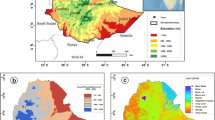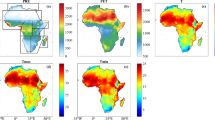Abstract
As the highest and most extensive plateau on earth, the Tibetan Plateau has strong thermo-dynamic effect, which not only affects regional climate around the plateau but also temperature and precipitation patterns of itself. However, due to scattered meteorological stations, its spatial precipitation pattern and, especially, the mechanism behind are poorly understood. The availability of spatially consistent satellite-derived precipitation data makes it possible to get accurate precipitation pattern in the plateau, which could help quantitatively explore the effect and mechanism of mass elevation effect on precipitation pattern. This paper made full use of TMPA 3B43 V7 monthly precipitation data to track the trajectory of precipitation and identified four routes (east, southeast, south, west directions) along which moisture-laden air masses move into the plateau. We made the assumption that precipitation pattern is the result interplay of these four moisture-laden air masses transportation routes against the distances from moisture sources and the topographic barriers along the routes. To do so, we developed a multivariate linear regression model with the spatial distribution of annual mean precipitation as the dependent variable and the topographical barriers to these four moisture sources as independent variables. The result shows that our model could explain about 70% of spatial variation of mean annual precipitation pattern in the plateau; the regression analysis also shows that the southeast moisture source (the Bay of Bengal) contributes the most (32.56%) to the rainfall pattern of the plateau; the east and the south sources have nearly the same contribution, 23.59% and 23.48%, respectively; while the west source contributes the least, only 20.37%. The findings of this study can greatly improve our understanding of mass elevation effect on spatial precipitation pattern.
Similar content being viewed by others
References
Alpert P (1986) Mesoscale indexing of the distribution of orographic precipitation over high mountains. Journal of Climate and Applied Meteorology 25(4): 532–545. DOI: 10.1175/1520-0450(1986)025
Anders AM, Roe GH, Hallet B, et al. (2006) Spatial patterns of precipitation and topography in the Himalaya. Special Papers-Geological Society of America 398: 39–53. DOI: 10.1130/2006.2398(03)
Basist A, Bell GD, Meentemeyer V (1994) Statistical relationships between topography and precipitation patterns. Journal of Climate 7(9): 1305–1315. DOI: 10.1175/1520-0442(1994)007<1305:SRBTAP>2.0.CO;2
Broccoli AJ and Manabe S (1992) The effects of orography on mid-latitude northern-hemisphere dry climates. Journal of Climate 5(11): 1181–1201. DOI: 10.1175/1520-0442(1992)005< 1181:TEOOOM>2.0.CO;2
Feng L and Zhou T (2012) Water vapor transport for summer precipitation over the Tibetan Plateau: Multi-dataset analysis. Journal of Geophysical Research: Atmospheres 117(D20): 85–99. DOI: 10.1029/2011JD017012
Fielding E, Isacks B, Barazangi M, et al. (1994) How flat is Tibet. Geology 22(2): 163–167. DOI: 10.1130/0091-7613(1994)022< 0163:hfit>2.3.co;2
Fu BP (1992) The effect of topography and elevation on precipitation. Acta Geographica Sinica 47(4): 302–314. (In Chinese)
Gao DY, Zou H and Wang W (1985) Influence of water vapor pass along the Yarlung Zangbo River on precipitation. Mountain Research 3(4): 239–249. (In Chinese)
Gao YC and Liu MF (2013) Evaluation of high-resolution satellite precipitation products using rain gauge observations over the Tibetan Plateau. Hydrology and Earth System Sciences 17(2): 837–849.
Hao ZC, Tong K, Zhang LL, et al. (2011) Applicability analysis of TRMM precipitation estimates in the Tibetan Plateau. Journal of China Hydrology 31(5): 18–23. (In Chinese)
Huang FJ and Shen RJ (1984) Analysis on water vapor sources and budget of the Tibetan Plateau in the summer monsoon. In: Meteorology science symposium of Tibetan Plateau (1). Science Press, Beijing, China. pp 215–224. (In Chinese)
Huffman GJ, Bolvin DT, Nelkin EJ, et al. (2007) The TRMM Multi-satellite Precipitation Analysis (TMPA): Quasi-global, multiyear, combined-sensor precipitation estimates at fine scales. Journal of Hydrometeorology 8(1): 38–55. DOI: 10.1175/jhm560.1
Jarvis A., Reuter HI, Nelson A, et al. (2008) Hole-filled SRTM for the Globe Version 4, available from the CGIAR-CSI SRTM 90m Database (http://srtm.csi.cgiar.org).
Ji X and Chen YF (2012) Characterizing spatial patterns of precipitation based on corrected TRMM 3B43 data over the mid Tianshan Mountains of China. Journal of Mountain Science 9(5): 628–645. DOI: 10.1007/s11629-012-2283-z
Jia SF, Zhu WB, Lu AF, et al. (2011) A statistical spatial downscaling algorithm of TRMM precipitation based on NDVI and DEM in the Qaidam Basin of China. Remote Sensing of Environment 115(12): 3069–3079. DOI: 10.1016/j.rse.2011.06.009
Kalnay E, Kanamitsu M, Kistler R, et al. (1996) The NCEP/NCAR 40-year reanalysis project. Bulletin of the American Meteorological Society 77(3): 437–471.
Kumari SS (2012) Multicollinearity: Estimation and elimination. Journal of Contemporary Research in Management 3(1): 87–95.
Kummerow C, Barnes W, Kozu T, et al. (1998) The Tropical Rainfall Measuring Mission (TRMM) sensor package. Journal of Atmospheric and Oceanic Technology 15(3): 809–817. DOI: 10.1175/1520-0426(1998)015<0809:ttrmmt>2.0.co;2
Liao K (1990) The Atlas of the Tibetan Plateau. Science Press, Beijing, China. p 66. (In Chinese)
Lin ZY and Wu XD (1990) A preliminary analysis about the tracks of moisture transportation in the Qinghai-Xizang Plateau. Geographical Research 9(3): 33–40. (In Chinese)
Lin ZY and Zheng D (1991) Moisture transportation pathways to the Qinghai-Tibetan Plateau and their geoecological significance. Chinese Journal of Arid Land Research 4(1): 41–47.
Lin ZY, Zhang XQ and Yin ZY (2000) Climate: past, present, and future. In: Zheng D, et al. (eds.), Mountain Geoecology and Sustainable Development of the Tibetan Plateau. Kluwer Academic Pub 57, Springer, Netherlands. pp 89–112.
Lin ZQ, Wen SJ and Zhou ZB (2013) The objective clustering of tropical storms tracks over the Bay of Bengal. Journal of Tropical Meteorology 29(6): 973–983. (In Chinese)
Liu GW (1992) Hydro-meteorological characteristics of the Tibetan Plateau. Journal of Hydraulic Engineering 5: 1–8. (In Chinese)
Liu XD and Yin ZY (2002) Sensitivity of East Asian monsoon climate to the uplift of the Tibetan Plateau. Palaeogeography, Palaeoclimatology, Palaeoecology 183(3-4): 223–245.
Liu XH, Yang QK, and Tang GA (2001) Extraction and application of relief of China based on DEM and GIS methods. Bulletin of Soil and Water Conservation 21(1): 57–59. (In Chinese)
Lu CX, Wang L, Xie GD, et al. (2007) Altitude effect of precipitation and spatial distribution of Qinghai-Tibetan Plateau. Mountain Research 25(6): 655–663. (In Chinese)
Owen LA, Finkel RC, Barnard PL, et al. (2005) Climatic and topographic controls on the style and timing of late Quaternary glaciation throughout Tibet and the Himalaya defined by 10 Be cosmogenic radionuclide surface exposure dating. Quaternary Science Reviews 24(12): 1391–1411. DOI: 10.1016/j.quascirev.2004.10.014
Peixoto JP and Oort AH (1983) The atmospheric branch of the hydrological cycle and climate. In: Street P et al. (eds.), Variations in the global water budget. Springer, Netherlands. pp 5–65.
Qi WW, Zhang BP, Pang Y, et al. (2013) TRMM-data-based spatial and seasonal patterns of precipitation in the Qinghai-Tibet Plateau. Scientia Geographica Sinica 33(8): 999–1005. (In Chinese)
Qian ZA and Shan FM (1984) Analysis on primary vortex in rainy season in the west of the Tibetan Plateau. In: Meteorology science symposium of Tibetan Plateau (1). Science Press, Beijing, China. pp 229–242. (In Chinese)
Roe GH (2005) Orographic precipitation. Annual Review of Earth and Planetary Sciences 33: 645–671. DOI: 10.1146/annurev.earth.33.092203.122541
Tu HM and Liu ZD (1990) Demonstrating on optimum statistic unit of relief amplitude in China. Journal of Hubei University (Natural Science) 12(3): 266–271. (In Chinese)
Xu JM and Zheng XJ (1996) Upper tropospheric moisture distribution over the Tibetan Plateau as revealed from GMS-5 water vapor images. Quarterly Journal of Applied Meteorology 7(2): 246–251. (In Chinese)
Yang YC, Gao DY and Li BS (1987) A preliminary analysis on the tracks of moisture transportation in the lower reaches of the Yarlung Zangbo River. Science in China (series D) 8: 893–902. (In Chinese)
Yao YH and Zhang BP (2015) The mass elevation effect of the Tibetan Plateau and its implications for alpine treelines. International Journal of Climatology 35(8): 1833–1846. DOI: 10.1002/joc.4123
Ye DZ and Wu GX (1998) The role of the heat source of the Tibetan Plateau in the general circulation. Meteorology and Atmospheric Physics 67(1-4): 181–198.
You QL, Fraedrich K, Ren GY, et al. (2012) Inconsistencies of precipitation in the eastern and central Tibetan Plateau between surface adjusted data and reanalysis. Theoretical and Applied Climatology 109(3-4): 485–496.
Zeng H, Li L and Li J (2012) The evaluation of TRMM Multisatellite Precipitation Analysis (TMPA) in drought monitoring in the Lancang River Basin. Journal of Geographical Sciences 22(2): 273–282. DOI: 10.1007/s11442-012-0926-1
Zhao F, Zhang BP, Zhang S, et al. (2015) Contribution of mass elevation effect to the altitudinal distribution of global treelines. Journal of Mountain Science 12(2): 289–297. DOI: 10.1007/s11629-014-3223-x
Zhang BP (1990) Physical features and vertical zones of the Karakoram and Ngari-Karakoram Mountains. Journal of Arid Land Resources and Environment 4(2): 49–63. (In Chinese)
Zhang BP (2000) Kunlun Mountains Region. In: Zheng D, et al. (eds.), Mountain Geoecology and Sustainable Development of the Tibetan Plateau. Kluwer Academic Pub 57, Springer, Netherlands. pp 349–372.
Zheng XJ, Xu JM and Li XZ (1997) Characteristics of water vapor transfer in upper troposphere over Qinghai-Xizang Plateau in summer. Plateau Meteorology 16(3): 274–281. (In Chinese)
Author information
Authors and Affiliations
Corresponding authors
Additional information
http://orcid.org/0000-0002-8439-4339
http://orcid.org/0000-0003-4298-9526
http://orcid.org/0000-0002-3520-1078
http://orcid.org/0000-0001-9225-104X
http://orcid.org/0000-0001-7842-5875
http://orcid.org/0000-0002-9155-3393
Rights and permissions
About this article
Cite this article
Qi, Ww., Zhang, Bp., Yao, Yh. et al. A topographical model for precipitation pattern in the Tibetan Plateau. J. Mt. Sci. 13, 763–773 (2016). https://doi.org/10.1007/s11629-015-3522-x
Received:
Revised:
Accepted:
Published:
Issue Date:
DOI: https://doi.org/10.1007/s11629-015-3522-x




